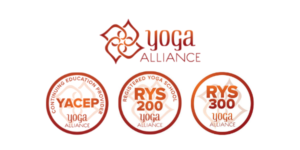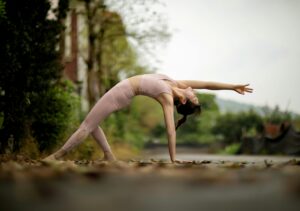Dhanurasana, also known as Bow Pose, is a powerful yoga asana (pose) that derives its name from the Sanskrit words “dhanura” (bow) and “asana” (pose), symbolizing a bow pulled taut in preparation to release an arrow. This posture is celebrated for its many benefits, including enhanced flexibility, core strength, and improved spinal health. Suitable for practitioners at various levels, Dhanurasana can be a profound addition to any yoga routine.

Benefits of Dhanurasana
- Strengthens the Back and Spine: Dhanurasana helps in strengthening and toning the back muscles, particularly in the lower back, which supports spinal alignment and overall flexibility.
- Stretches the Chest and Shoulders: In the pose, the chest opens up, allowing a deeper stretch across the shoulders and thoracic area, which can improve posture and breathing capacity.
- Enhances Digestion: As the abdomen is pressed against the floor, it creates a natural massage for the digestive organs, which can improve digestion and alleviate constipation.
- Boosts Energy Levels: By opening the chest and stretching the entire body, this pose increases blood flow, promoting a sense of rejuvenation and energy.
How to Perform Dhanurasana
To practice Dhanurasana safely:
- Lie Down: Begin by lying on your stomach with your arms at your sides and your forehead resting on the mat.
- Bend Your Knees: Slowly bend your knees and reach back with your hands to grab your ankles.
- Lift Your Body: Inhale deeply, and as you exhale, lift your chest, head, and thighs off the floor. Focus on creating a natural arch in your spine.
- Hold the Position: Hold the pose for a few deep breaths, feeling the stretch in your entire body.
- Release: Exhale and gently release your ankles, lowering your body back to the mat.
Precautions and Contraindications
While Dhanurasana offers numerous benefits, it’s essential to approach the pose mindfully:
- Avoid practicing this pose if you have high blood pressure, hernia, back pain, or recent abdominal surgery.
- Pregnant women should avoid this posture, as it puts pressure on the abdomen.
- Always warm up before attempting Dhanurasana, especially if you are new to back-bending poses.
Variations and Modifications
If you’re new to Dhanurasana or looking for variations:
- Half Bow Pose (Ardha Dhanurasana): Practice lifting one leg at a time, especially if you find the full expression challenging.
- Use a Strap: If reaching your ankles is difficult, use a yoga strap around your ankles to assist in the stretch.
Integrating Dhanurasana Into Your Yoga Practice
Dhanurasana can be an integral part of your yoga routine, especially following warm-up poses like Cobra Pose (Bhujangasana) or Camel Pose (Ustrasana). For cooling down, Child’s Pose (Balasana) can be helpful to release any tension in the spine.
Conclusion
Dhanurasana is more than a physical exercise; it is a pose that can enhance mental focus, flexibility, and overall health when practiced mindfully. Incorporating Dhanurasana into your yoga routine can bring strength and suppleness to your back, while promoting relaxation and energy balance.
Detailed Guide on Dhanurasana Benefits – Yoga Journal provides an in-depth look at the benefits of Dhanurasana for strength, flexibility, and reducing stress. Visit Yoga Journal.
Yoga Sequence Incorporating Dhanurasana – Explore a yoga sequence that includes Dhanurasana and other backbends for overall spinal health on Yoga Basics. Check Yoga Basics.








